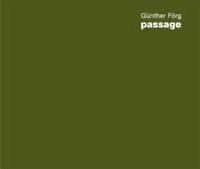You can make something out of nothing Some of the current batch of watercolours were originated on partially sullied sheets of paper, on sheets that had been used either as an underlay for the painting of other watercolours or one that were to hand during this process in order that the artist could dab his brush now and then or test the value of a particular colour. Such literal »working papers« now form the basis for watercolours and paintings, which cover the whole range from cheery fields of paint blots to an intensive encounter between different principles of form. It is self-evident that the quasi self-originating beginnings of this new »pictorial language« also deal with the phenomenon of horror vacui, which on the one hand equivocally demands that the emptiness – the pure white of the canvas – should be done away with and yet in so doing, simultaneously induces a high degree of anxiety, rendering any composition a sheer impossibility. We can forge a connection to French Impressionism, which was quite literally thrown back upon the essence of the blot in its quest for that true visual insight and depiction of the world, as we also could see in these paintings the contemporary answer for that depiction.Rien ne reste ce qu’il est Certaines des aquarelles présentées ici ont été peintes sur des feuilles en partie salies – des feuilles qui avaient servi de sous-mains pour peindre d’autres aquarelles ou qui étaient à portée de la main de l’artiste pour qu’il y dépose des touches de pinceau afin de vérifier la nuance d’une couleur. Ce sont ces papiers brouillons, au sens propre du mot, qui forment désormais la base d’aquarelles et de peintures, des étendues de taches gaies et légères à la confrontation intense entre différents principes formels. Les débuts de ce nouveau « langage imagé » formé pour ainsi dire à partir de lui-même traitent bien entendu aussi le phénomène de la peur du vide qui exige à double sens, d’une part d’en finir avec le vide, la page blanche, alors même que cela éveille des peurs qui rendent quasi-impossible de fixer une image.
Peut-être un lien avec l’impressionisme français peut-il même être noué qui, avec sa recherche de la véritable connaissance visuelle et sa représentation du monde, a été littéralement renvoyé à l’essence de la tache. Cette tache n’est en effet rien d’autre que celle à partir de laquelle la vision impressionniste du monde est construite en peinture sous forme de fragmentation extrême de la réalité visible, nous pouvons donc déjà voir dans ces tableaux la réponse contemporaine à cette fragmentation de la réalité. Nichts bleibt was es ist Einige der vorliegenden Aquarelle entstanden auf teilweise beschmutzten Blättern. Auf Blättern, die als Unterlage für das Malen von anderen Aquarellen gedient hatten oder die bei dieser Tätigkeit in Reichweite lagen, sodass der Künstler auf ihnen mal seinen Pinsel abtupfen und dieses oder jenes Valeur einer Farbe überprüfen konnte. Solche Arbeitspapiere im eigentlichen Sinne des Wortes wurden nun zur Basis von Aquarellen und von Malereien, die von heiter wirkenden Fleckenfeldern bis zu intensiven Auseinandersetzungen zwischen unterschiedlichen Formprinzipien reichen. Die gleichsam aus sich selbst heraus gebildeten Anfänge dieser neuen 'Bildersprache' thematisieren selbstverständlich auch das Phänomen des Horror Vacui, das doppelsinnig verlangt, dass einerseits der Leere, dem reinen Weiß des Blattes der Garaus gemacht werden soll, während diese Aufgabe gleichzeitig Ängste weckt, die jede Setzung schier unmöglich machen. Vielleicht läßt sich sogar eine Beziehung zum französischen Impressionismus knüpfen, der in seiner Suche nach der wahrhaften visuellen Erkenntnis und Abbildung der Welt buchstäblich auf die Essenz des Flecks zurückgeworfen wurde. Denn dieser Fleck ist letztlich nichts anderes als die 'tache', aus der sich das impressionistische Bild der Welt als extreme Fragmentierung der sichtbaren Wirklichkeit in der Malerei aufbaut, und da können wir in diesen Bildern schon die zeitgenössische Antwort auf diese Fragmentierung der Wirklichkeit sehen.

